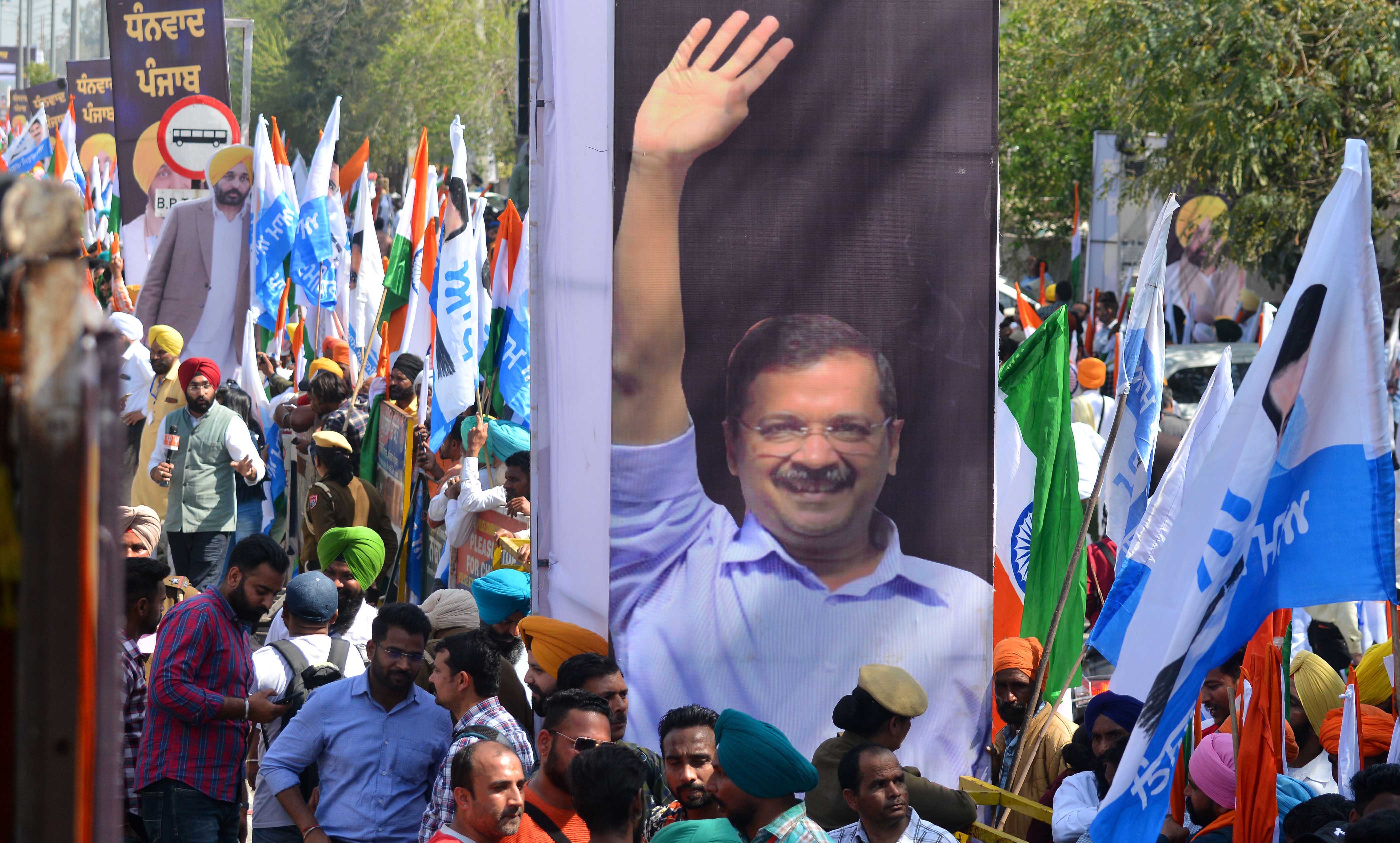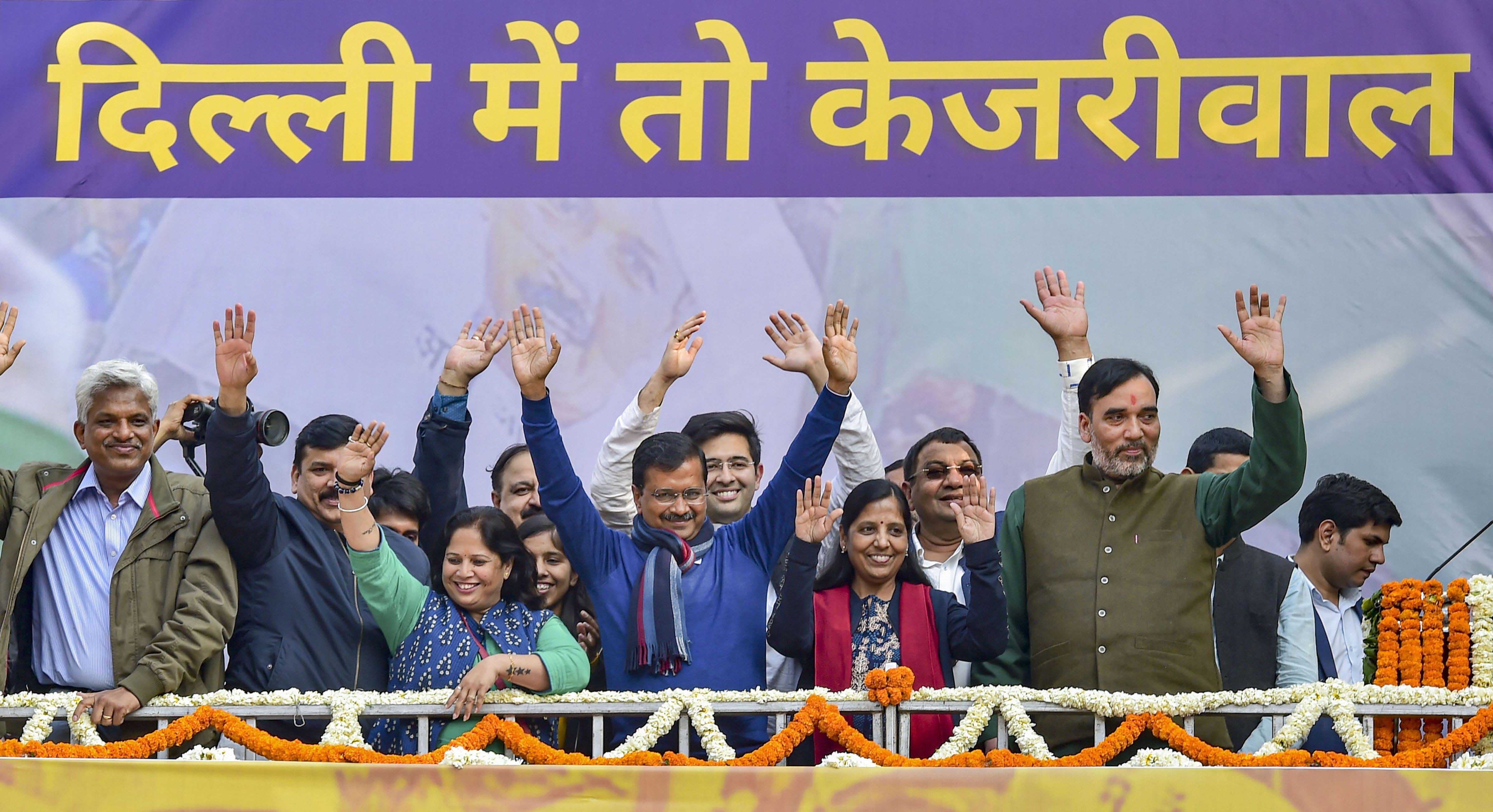
Since the time Kejriwal broke ranks with Anna Hazare giving a go-by to his diktat of keeping away from politics, he has gone from strength to strength, his latest feat being a thumping win in Punjab
When Arvind Kejriwal, currently Delhi’s Chief Minister, had shared stage with crusader Anna Hazare well into the new millennium, little did he know that one day he will be a force to reckon with; neither had he fathomed that his journey from the Ram Lila ground in India’s capital city would follow a trajectory that others would strive to emulate; or that from being a second rung leader in the Hazare movement, the front rankers being activists Kiran Bedi and Prashant Bhushan, he would deal a winning hand.
What a rise and what a win: today Kejriwal and his Aam Aadmi Party has taken a giant leap and dwarfed the giants.
It was in 2011 that Kejriwal teamed up with Hazare to launch a movement against corruption. The movement gathered steam when Hazare went on a hunger strike to press for a Lokpal Bill. Thousands expressed solidarity with Hazare, some even joining him in his hunger strike. Exhorting his supporters, Hazare had then said: “You don’t become Anna by wearing the Anna topi; you become Anna practicing my principles”.
Kejriwal walked half way: he wore the topi but did not follow Hazare’s principles.
Back in those days, Anna followers stood out as they donned Gandhi caps with Main Anna Hoon or I am Anna inscribed on them. Hazare had also made it clear that he will strive to keep the anti-corruption movement free of politics.
Kejriwal broke ranks: he used the topi to the hilt, but gave a go-by to Hazare’s diktat of keeping away from politics.
Even as many of Hazare’s supporters dubbed him traitor, Kejriwal went ahead and launched the Aam Aadmi Party, currently popular as AAP.
Minus Hazare, the Gandhi topi, led by Kejriwal, dominated with an altered inscription: “Main hoon aam aadmi”, roughly translated as I am a common man or as Robert Vadra, Priyanka Gandhi’s husband, would say: the mango people.
The Indian Revenue Service officer-turned-activist turned politician, Arvind Kejriwal had finally come out on his own.
Along with the topi, two other things distinguished him: a muffler and a persistent cough. With Time and perhaps success, both have disappeared: the muffler because it is not deemed necessary and the cough because Kejriwal underwent a surgery.
For someone who had to be pushed onto the stage during the Anna Hazare days, the muffler-man as Kejriwal later came to be known, emerged from the shadows to speak to an enthused audience. Neither charismatic nor a great orator, Kejriwal connected with the common man with a I am one of you sentiment.
Rather than one who savours international cuisines, Kejriwal comes across as the dal chawal types: a kind of a misfit in Lutyens Delhi. It is this image, Kejriwal milked to his political advantage, appealing to the autorickshaw driver instead of those in swanky cars.
Kejriwal’s strength is the man on the street and one who loves freebies. His appeal is to the nowhere people as it were. And that is why when the elite or the suit-boot types sneer at him, it works as nothing else does.
Agitation is in Kejriwal’s blood. Hence he found it difficult to adapt to the dignity of the political office he held for the first time as Delhi’s Chief Minister. He took to the streets soon after and led a protest outside the Rail Bhawan; resigned after 49 days and proposed elections; in his second term as Chief Minister, he sat on a dharna near the Lt. Governor’s office raising slogans against a Constitutional head, leading many to ask: Is this how a Chief Minister should behave? Should he govern or fuel the fire?
Irrespective, Kejriwal has gone from strength to strength, his latest feat being the resounding victory in the recently concluded Punjab elections, quite similar to 2015 when AAP won 67 of the 70 constituencies in Delhi. In Punjab it has bagged 92 of the 117 seats.
The comparison is not of numbers but one that demonstrates that AAP’s national journey has just begun. Apart from being the only Opposition Party in the country to currently rule over two states, it is also one that has replaced the Congress as a major challenger to the BJP. Equally it is true, that to be a major player and get a national footprint it still has miles to cover.
But what does the Punjab victory mean for AAP? What does it mean for the BJP? And what does it mean for the nation? These are direct questions; yet those that have no straight answers.
To take the first: Punjab.
To call the results a victory for AAP would perhaps be an understatement; to say it was a tsunami would perhaps be stating the obvious. Nothing can sum it up better than AAP leader Raghav Chadha’s observation: “AAP had appealed to the people to use jhadu in Punjab but they decided to switch onto the vacuum cleaner”. The jhadu or the broom, is AAP’s electoral symbol.
The chief contestants of the Punjab-show were AAP and the ruling Congress in the state. But that was only till the tally was out. Looking at its poor showing, it is quite clear that there was no contest: the grand old Party recorded its worst tally in two decades: a dismal 18 seats from the 77 it had wrested five years ago. Therefore it would not be wrong to conclude that there was no opposition worth the name that AAP was facing in this beleaguered state.
Add to this, the Delhi model that tempted the people to root for AAP. More than governance, the freebies-carrot that AAP dangled worked in its favour.
The promise of free and uninterrupted supply of electricity to a state which had surplus power but was saddled with an erratic supply was a temptation difficult to resist. Add to this free water, waiver of outstanding electricity bills and state of the art government run schools, sending teachers abroad for training and permanent recruitment of vacant posts made AAP the best bet for the electorate.

That these will not be empty promises was substantiated by the fact that AAP had already implemented much of this in Delhi. In fact it is this more than the promises that helped AAP cross the untried entity hurdle. Its Delhi track- record had helped it establish its credibility and trust quotient with the people of Punjab.
While AAP as a Party is on a strong wicket, its nominee Bhagwant Singh Mann has a debit account. Given his track record, the AAP leadership will have to handhold him and ensure that power does not “intoxicate” him. In Mann’s case the pun is intended.
Mann’s weakness for alcohol made headlines in the past. If a Lok Sabha MP had requested the Speaker for a change of his seat on grounds that Mann was “stinking of alcohol”, his alleged drunken behaviour had earned him the sobriquet Pegwant Mann. On his part, Mann has publicly sworn “never to touch alcohol”.
If Mann were not to rock the boat, then Punjab has decidedly charted AAP’s future course. This election has decidedly helped it to expand its footprint beyond Delhi’s neighbouring states.
In Goa for instance, AAP made an entry by winning two assembly seats. These are good tidings for a Party that had failed to open its account in the coastal state when it had contested the state elections for the first time in 2017. Therefore AAP’s win may be Punjab but its success story includes Goa as well.
Equally, what is significant is that it trounced the Trinamool Congress, headed by West Bengal Chief Minister Mamata Banerjee. This throws up an interesting question and that being: Can AAP give the TMC a run for its money? Pitched against Banerjee, will Kejriwal be a force to reckon with? If Goa is anything to go by then both the BJP and TMC have a lot to worry about.
AAP vanquishing TMC in Goa has suddenly pitched Banerjee’s party against a non-BJP competitor. Till now the TMC had one enemy in the BJP; now it also has a contender in AAP. This is a double whammy which the TMC could well have done without.
As for the BJP, the AAP demon, as it sees the rise of Kejriwal’s party, is something which the saffron Party can ill afford to ignore.
Given AAP’s stated intention of contesting the forthcoming elections in the states of Gujarat and Himachal Pradesh, the danger looms large.
Punjab has surely shown the way and therefore the “bigger role” that AAP leaders are now talking of, could be ominous. Also their stating that the Party will “emerge as a major national political force” are words that do not ring hollow. Irrespective of the Opposition unity, AAP is quite prepared to go for the kill on its own.
If the current scenario is anything to go by, the Congress may have to cede space to AAP as an alternative to the BJP. That AAP is inching towards that possibility is clear by its recent pronouncements courtesy Chadha yet again, about wherein he has asserted AAP being the “national and natural replacement to the Congress in the near future.
Also, Chadha’s statement about the Punjab Congress’s “broth being spoiled by a dozen cooks pulling each other’s apron” could find resonance at the national level. Substitute Punjab Congress with a medley of Opposition parties, TRS, NCP, TMC et al, trying to come together with little success and it could be a broth with too many cooks at the national level.
2024 may be far and the national scenario a bit hazy but if the BJP is sitting smug because of a fragmented Opposition, the Modi charisma and a decimated Congress, it should think twice because AAP has not only arisen but is all set to take the national plunge. Therefore its threat that when “aam aadmi”, common man, rises, the mightiest of thrones shake may be a bit far- fetched but it certainly is not a pipe dream.













